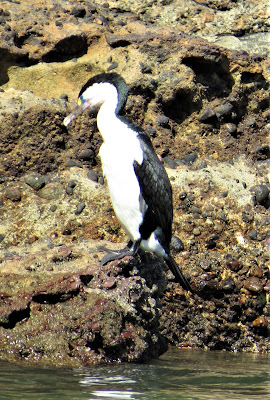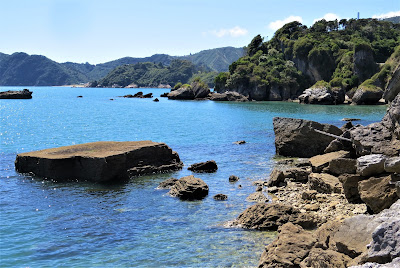 |
| Our room's deck overlooking Golden Bay at the Bay Lodge in Pohara. This was my favorite of all the places we stayed during several weeks in New Zealand. |
The northwest corner of New Zealand's South Island contains, among other things, Wharariki Beach, Golden Bay, Te Waikoropupu Springs, Abel Tasman National Park and the Bay Lodge in Pohara, where we spent two nights, February 28 and March 1, 2023, during our several-week visit to New Zealand.
Our room at the Bay Lodge had a private terrace overlooking Golden Bay, which got its name after the 1857 discovery of gold nearby. Our innkeeper, however, pointed us elsewhere: Te Waikoropupu Springs and Wharariki Beach, both of which were worth the walks needed to see them. At the beach, after a long drive on a gravel road and a half-hour hike over a series of hills we were rewarded by sweeping vistas of white sand studded with giant rocks. He described it as the world's most beautiful beach. I think it should certainly make a list of finalists in that category.
The springs are protected to a degree few natural sites are in the United States. No swimming, no putting one's hand in the water, etc. Even though there is a trail and even a deck overlooking the main spring, the idea is to keep this place as pristine as possible but still allow people to see it.
New Zealand's zeal in protecting its natural environment is probably unmatched in the world. The government has a goal of getting rid of animal predators in the foreseeable future. Prior to the arrival of Europeans, there were virtually no predators on the islands other than Maori hunters. Opossums, rats and feral cats are threats to the survival of ground-nesting birds. On many trails we came across traps set for catching these predators, and people in New Zealand speak of opossums with a degree of animosity that might remind you of ranchers in the U.S. discussing wolves or coyotes.
Pohara is a tiny community without much of a commercial district. The nearby town of Takaka is the place to go to fuel up a car, shop or find casual places to eat. It has a tie-dyed vibe that reminded me of 1970s headshops in the U.S. We had pizza our first night there at Dangerous Kitchen. Great ambience, and the place had a lot of happy diners, but I think pizza is something you should not order in New Zealand. A good dinner the next night and then breakfast on our way out of town was at Ratanui Lodge practically around the corner from the Bay Lodge.
Here are some photos:
 |
| This shag, which is what cormorants are called in New Zealand, was at Wharariki Beach. |
 |
| A tidal lagoon at Wharariki. |
 |
| The trail to Wharariki takes 20 to 30 minutes. |
 |
| The road from Pohara to the northern part of Abel Tasman National Park. |
 |
| The rugged coast between Pohara and Abel Tasman. |
 |
| The beach at Totaranui features coarse sand and a lack of crowds despite its popular campground |
 |
| Another view of the beach at Totaranui. Several New Zealanders told us that during this rainy and chilly summer they had not been to a beach at all. |
 |
| We drove, mostly on a gravel road, for over an hour from Pohara to reach this beach. Many other Abel Tasman beaches have no road access at all and visitors reach them via water taxies such as this. |
 |
| This sign at a marina near Pohara indicates how seriously New Zealanders are about protecting their environment, especially the waters. |
 |
| The small type here reminds hikers to keep their equipment clean to avoid transfering plant pests from one area to another. |
 |
| We saw traps such as this along trails all over New Zealand. The country is serious about eliminating opossums and other predators that threaten ground-nesting birds. |
 |
| Cumbersome names are part of New Zealand's Maori legacy. Many New Zealand businesses use the Maori names for towns. Aotearoa is the Maori name for New Zealand and is widely used. |
 |
| Parts of the springs have a sandy bottom and sand is carried upward by the gushing water creating what's called "dancing sands." |
 |
| A sign in Maori at the springs, which have traditionally had spiritual significance for the Maori people. |
 |
| You're wecome. |


No comments:
Post a Comment